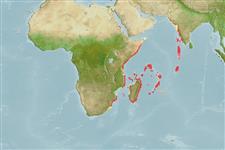>
Pleuronectiformes (Flatfishes) >
Soleidae (Soles)
Etymology: Aseraggodes: Greek, aggos, -eos, -ous = vessel, uterus, carapace of a crab + Greek, aseros, -a, -on = to remove the appetite (Ref. 45335).
Eponymy: Alain Diringer is an underwater photographer. [...] (Ref. 128868), visit book page.
Environment: milieu / climate zone / depth range / distribution range
Ekologi
laut dasar (demersal); kisaran kedalaman 0 - 35 m (Ref. 57561). Tropical
Western Indian Ocean: Kenya to Chagos Archipelago, south to KwaZulu-Natal.
Size / Weight / umur
Maturity: Lm ? range ? - ? cm
Max length : 10.4 cm SL jantan/; (Ref. 33390)
deskripsi pendek
Kunci identifiaksi (pengenalan) | Morfologi | Morfometrik
duri punggung lunak (Keseluruhan (total)) : 68 - 76; Sirip dubur lunak: 47 - 52; vertebrata, bertulang belakang: 35 - 38. Diagnosis: Dorsal rays 68-76; anal rays 47-52; dorsal, anal, and pelvic rays are branched; lateral line scales 75-87, including about 11 anterior to a vertical at upper end of gill opening; lateral line on ocular side projecting toward dorsal edge of upper eye; vertebrae 35-38; dorsal pterygiophores anterior to fourth neural spine 13-15; body depth 2.3-2.6 in SL; head length (HL) 4.2-4.6 in SL; snout length 2.6-2.75 in HL; eye diameter 4.5-5.8 in HL; interorbital space narrow, the least vertical width 9.0-12.5 in HL; maxilla ending anterior to a vertical through middle of lower eye; upper end of gill opening on a horizontal passing about a half orbit diameter below lower eye; tubular anterior nostril reaching cutaneous edge of lower orbit when laid back; cirri well developed on front of snout, ventral side of head, operculum along both sides of gill opening, and along edge of membranous ridges of most dorsal and anal rays; caudal peduncle present, length 7.0-10.5 in HL; caudal-peduncle depth 1.65-1.9 in HL; longest dorsal ray 1.4-1.65 in HL; caudal-fin length 3.1-3.8 in SL; pelvic-fin length 1.55-1.75 in HL, reaching base of third or fourth anal ray; color of ocular side in alcohol light brown with many small dark brown spots or short lines and three rows of larger dark brown spots (though usually no larger than eye), one row below dorsal fin, one above anal fin, and one along lateral line; rays of fins light yellowish brown with a single series of brown spots, those on some rays darker than others. Head and body when fresh with numerous small white spots (but larger than small dark brown spots); with a series of white spots, one dorsally and one ventrally on body, of equal size to dark brown spots, one between each pair of dark spots (Ref. 57561).
Collected from clear water in a coral-reef environment; the deepest from sand beneath a ledge in 35 m depth (Ref. 57561).
Life cycle and mating behavior
Kematangan | Reproduksi, perkembang biakan | Pemijahan | telur-telur | Fecundity | Larva
Fricke, R., 1999. Fishes of the Mascarene Islands (Réunion, Mauritius, Rodriguez): an annotated checklist, with descriptions of new species. Koeltz Scientific Books, Koenigstein, Theses Zoologicae, Vol. 31:759 p. (Ref. 33390)
Status IUCN Red List (Ref. 130435: Version 2024-2)
ancaman kepada manusia
Harmless
penggunaan manusia
Alat, peralatan
laporan khas
muat turun XML
Sumber internet
Estimates based on models
Preferred temperature (Ref.
123201): 25 - 28.9, mean 27.3 °C (based on 366 cells).
Phylogenetic diversity index (Ref.
82804): PD
50 = 0.5000 [Uniqueness, from 0.5 = low to 2.0 = high].
Bayesian length-weight: a=0.00977 (0.00466 - 0.02049), b=3.07 (2.90 - 3.24), in cm total length, based on LWR estimates for this (Sub)family-body shape (Ref.
93245).
Trophic level (Ref.
69278): 3.6 ±0.5 se; based on size and trophs of closest relatives
Daya lenting (Ref.
120179): Tinggi, Waktu penggandaan populasi minimum kurang dari 15 bulan (Preliminary K or Fecundity.).
Fishing Vulnerability (Ref.
59153): Low vulnerability (10 of 100).
